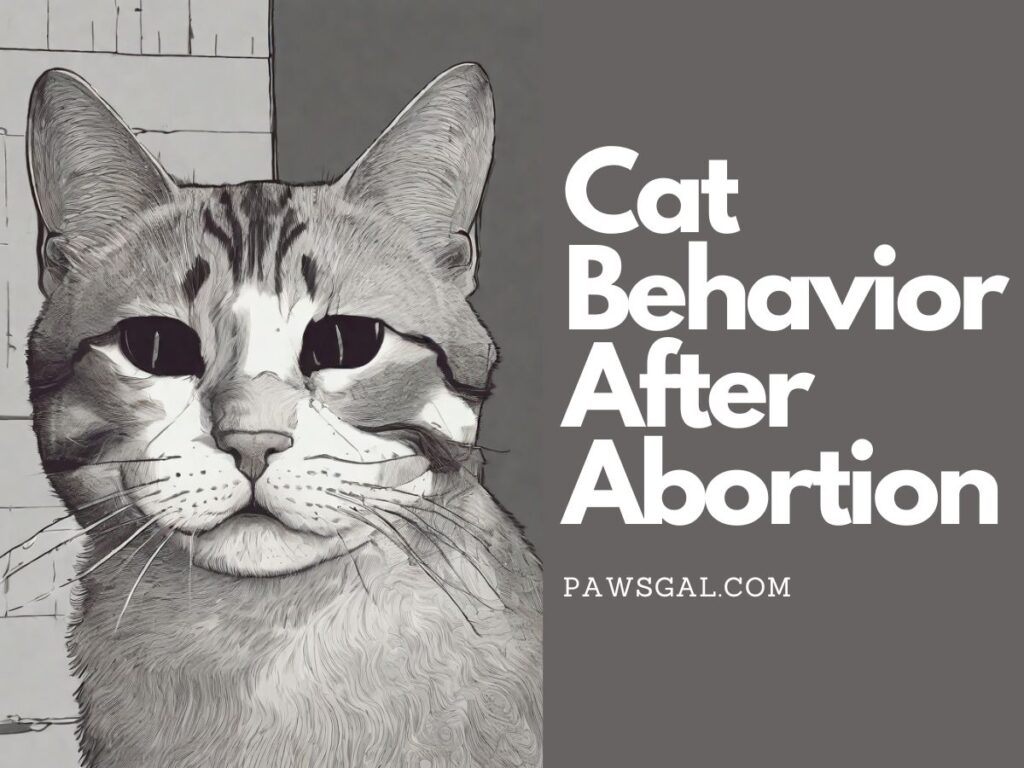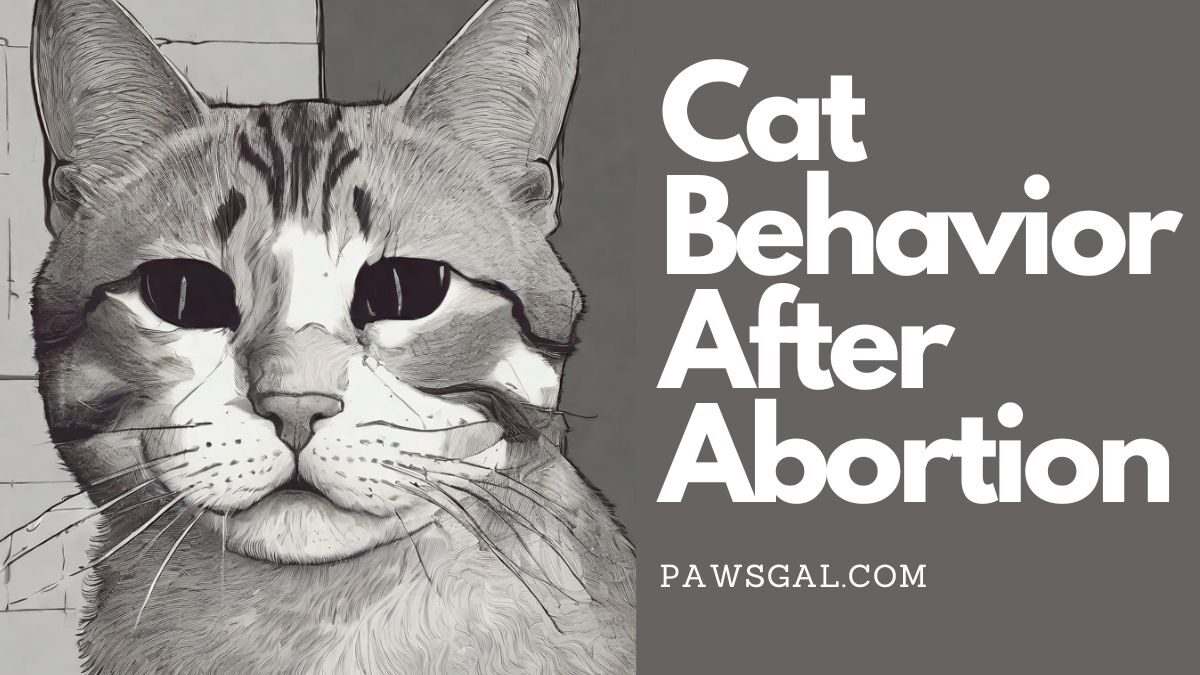
Cats, similar to humans, go through a variety of emotions and behavioral changes following an abortion. It’s important to recognize and comprehend these shifts in order to provide the necessary support for their recovery and help them regain a sense of normalcy.
What is the cat behavior after abortion?
After undergoing an abortion, cats may exhibit various behavioral changes. They might display signs of sadness, anxiety, and confusion as they mourn the loss of their kittens. Some cats may become more withdrawn, spending more time hiding or sleeping. Changes in appetite, such as a loss of appetite or excessive eating, can also occur. Additionally, cats might show uncharacteristic aggression or become more vocal than usual. It’s important to note that each cat’s behavior can vary, and the intensity and duration of these changes can be influenced by several factors, including the cat’s individual personality and the circumstances surrounding the abortion. Providing a supportive and nurturing environment can help cats navigate through these behavioral shifts and facilitate their emotional recovery.
Table of Contents
I. Understanding Cat Behavior After Abortion
A. Psychological Impact
Post-abortion, cats may exhibit emotional distress. They might display signs of confusion, anxiety, or even depression. This psychological impact can manifest through changes in their routine behavior. It’s important to closely observe their behavior and provide the necessary support and care to help them navigate through these emotional challenges.
B. Physical Changes
Physically, cats might display signs of discomfort, such as reduced activity, changes in appetite, or altered grooming habits. These can be indicative of their adjustment to the physical changes post-abortion. It’s crucial to monitor their well-being closely and consult a veterinarian if any concerning symptoms persist. Providing a comfortable and soothing environment, along with proper veterinary care, can aid in their physical recovery and overall well-being.
II. Signs of Discomfort or Distress
A. Behavioral Cues
Watch for behavioral cues like increased hiding, avoidance, or excessive vocalization. These may signal their discomfort and emotional stress post the procedure. Paying attention to these behavioral cues is vital in understanding and addressing their emotional well-being. By creating a safe and supportive environment, offering reassurance, and seeking professional guidance if needed, we can help cats navigate through their emotional distress and promote their healing process.
B. Physical Symptoms
Keep an eye on physical symptoms like lethargy, loss of appetite, or any unusual bodily discharge. These signs might indicate complications or discomfort. It is crucial to promptly address any concerning physical symptoms by consulting a veterinarian. Early detection and appropriate medical intervention can help ensure the cat’s well-being and prevent potential complications. By staying vigilant and seeking professional advice, we can provide the necessary care and support for cats during their post-abortion recovery.
III. Recovery and Support
A. Creating a Comforting Environment
Provide a quiet, comfortable space for the cat to recover. Ensuring a stress-free environment can aid in their emotional and physical healing. Creating a designated area with familiar bedding, toys, and a cozy hiding spot can help the cat feel secure and at ease. Minimizing loud noises, disruptions, and introducing a consistent routine can further contribute to their well-being. By offering a calm and nurturing space, we can support their recovery process and help them regain a sense of stability and comfort.
B. Seeking Veterinary Guidance
Consult a veterinarian to ensure the cat’s well-being. Professional guidance can provide essential insights into their recovery process and any necessary medical support. Regular check-ups and follow-up visits will allow the veterinarian to monitor the cat’s physical health and address any potential complications. They can also provide guidance on pain management, post-operative care, and any additional treatments that may be required. Collaborating with a veterinarian is crucial in ensuring the cat’s overall well-being and facilitating a smooth recovery after an abortion.
IV. Resuming Normalcy
A. Gradual Reintroduction to Routine
Slowly reintroduce their regular routine, maintaining patience and understanding for any changes they exhibit. After an abortion, cats may need time to readjust and regain their normalcy. Gradually reintroducing their usual activities, feeding schedule, playtime, and social interactions can help them feel secure and comfortable. It’s important to be patient and understanding if they display any behavioral changes or require extra reassurance during this transition period. By providing a supportive and consistent environment, we can help cats regain their confidence and stability as they recover from the emotional and physical impact of the abortion.
B. Patience and Monitoring
Monitor their behavior closely and be patient with their adjustment. Patience is key to their recovery process. After an abortion, cats may require time to adapt to the emotional and physical changes they have experienced. It’s crucial to observe their behavior, provide gentle reassurance, and allow them the space and time they need to heal. Each cat is unique, and their recovery timeline may vary. By practicing patience and understanding, we can support their journey towards emotional well-being and help them regain a sense of normalcy. Remember, with time and patience, cats can gradually overcome the challenges they face after an abortion and thrive once again.
V. Emotional Well-being
A. Bond Strengthening
Invest time in bonding and reassurance. Strengthening the bond can significantly aid in their emotional recovery. After an abortion, cats may benefit from increased bonding activities with their human companions. Spend quality time engaging in gentle play, offering soothing physical contact, and providing verbal reassurance. This helps create a sense of security and trust, promoting their emotional healing process. Additionally, maintaining a calm and loving presence can help alleviate any anxiety or sadness they may be experiencing. By investing time in bonding and reassurance, we can foster a strong connection and support their emotional well-being during this challenging time.
B. Coping Mechanisms
Implement coping mechanisms such as interactive play or engaging activities to divert their attention from the recent experience. After an abortion, cats may benefit from activities that stimulate their minds and bodies, helping them redirect their focus and energy. Interactive play sessions with toys, puzzle feeders, or engaging in gentle exercise can provide positive outlets for their emotions and help alleviate any lingering distress. By offering stimulating and enjoyable activities, we can help cats regain a sense of joy and normalcy, promoting their overall well-being and aiding in their emotional recovery.
VI. Conclusion
In conclusion, post-abortion, cats undergo emotional and physical changes that require attention and support from their human companions. Understanding their behavior, providing necessary care, and being patient are crucial in aiding their recovery. By recognizing and addressing their emotional distress, monitoring their physical well-being, and creating a nurturing environment, we can help cats navigate through this challenging time. Our understanding, patience, and commitment to their well-being can make a significant difference in their recovery process, allowing them to heal both emotionally and physically. By providing the necessary support, we can help cats regain their balance, resilience, and overall well-being after an abortion.
FAQs
- Can cats experience trauma post-abortion? Cats can undergo emotional distress post-abortion, which may manifest as behavioral changes or physical discomfort.
- How long does it take for a cat to recover after an abortion? Recovery varies per cat, but typically, they start showing signs of normalcy within a few days to a couple of weeks.
- Is it necessary to consult a vet after a cat’s abortion? Yes, it’s crucial to seek veterinary guidance post-abortion to ensure the cat’s physical and emotional well-being.
- What can I do to support my cat emotionally after an abortion? Spending quality time, providing a comfortable environment, and engaging in bonding activities can aid in their emotional recovery.
- Are there any warning signs to look out for after a cat’s abortion? Keep an eye on changes in behavior, appetite, and physical symptoms like discharge or lethargy, which might signal discomfort or complications.

